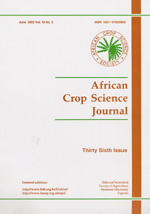
|
African Crop Science Journal
African Crop Science Society
ISSN: 1021-9730
EISSN: 1021-9730
Vol. 9, No. 1, 2001, pp. 257-266
|
 Bioline Code: cs01056
Bioline Code: cs01056
Full paper language: English
Document type: Research Article
Document available free of charge
|
|
|
African Crop Science Journal, Vol. 9, No. 1, 2001, pp. 257-266
| en |
The Effect of Crop Rotation on Bacterial Wilt Incidence and Potato Tuber Yield
Lemaga, Berga; Kanzikwera, R.; Kakuhenzire, R.; Hakiza, J.J. & Maniz, G.
Abstract
To determine the effects of crop rotation on potato bacterial wilt incidence
and tuber yields, one-and two-season rotation experiments were conducted during
1995-1999 at Kachwekano Agricultural Research and Development Centre located
at an altitude of 2200 meters in southwestern Uganda. Pulses, cereals, root
crops and vegetables commonly grown in the area were included in different sets
of rotation experiments. Each time, prior to planting the experiment, the field
was planted to a bacterial wilt susceptible potato variety and artificial inoculation
was also done, when needed, to achieve a somewhat uniform distribution of Ralstonia solanacearum. A one-season rotation in heavily infested field (>90% wilt
incidence) with wheat and maize did not significantly reduce wilt but increased
ware tuber yield, while the effects of phaseolus beans were not significant.
On the contrary, a one-season rotation in mildly infested field (about 15-20%
infestation) resulted in a significant reduction in wilt incidence as compared
to the control. The highest wilt incidence under rotation was below 13% as compared
to 62% in the control. Finger millet and sweetpotatoes reduced wilt the most,
while carrots and onions reduced the least. There were no significant yield
differences among the rotation treatments except for the control. A two-season
rotation on heavily infested soil reduced wilt to 22% - 49% as compared to 81%
in the control. The highest wilt reduction was obtained with potato-beans-maize-potato
treatment, while the lowest reduction was with potato-maize-maize-potato. Total
yields and ware potatoes increased from 3.2 t ha-1 with the control monocrop
to 9.3 - 11 t ha-1 with rotation and marketable yields increased from 1.8 t
ha-1 to 6.7 - 9.2 t ha-1. Planting different crops in two consecutive seasons
performed better than planting the same crop. Interestingly, sweetpotato, which
is a major staple food in the area this experiment was conducted, was found
to be a good rotation crop for reducing wilt. Beans, the most important food
crop and a protein source, but probably a symptom less carrier of Ralstonia solanacearum can be a good rotation crop if used before or after cereals in
a potato rotation scheme.
Keywords
Crop rotation, infestations, marketable yield, Solanum tuberosum, ware potatoes, wilt incidence
|
| |
| fr |
Lemaga, Berga; Kanzikwera, R.; Kakuhenzire, R.; Hakiza, J.J. & Maniz, G.
Résumé
Pour déterminer des effets de rotation des cultures sur l'incidence
de la bactériose et le rendement des tubercules, des essais d'une saison
et de deux saisons ont été conduits en 1995-1999 au centre de
développement et de recherche agricole de Kachwekamo, situé à
une altitude 2200 m au Sud-Ouest de l'Uganda. Des légumineuses à
gousses, des céréales, des plantes à racines et tubercules,
et des légumes communément cultivées dans cette région
ont été inclues dans des differentes séries d'essais de
rotation. Chaque fois, avant l' établissement de l'essai, le champ était
planté d'une variété de pomme de terre sensible à
la bactériose et une inoculation artificielle était faite, une
fois jugée nécessaire pour avoir une uniformité de la distribution
de Ralstonia solanacerum. Une saison de rotation dans un champ fortememnt infesté
(>90% d'incidence) avec le blé et le maïs n'a pas réduit
significativement le mildiou mais a augmenté le rendement des tubercules,
alors que les effets des haricots phaseolés n'ont pas été
importants. Au contraire, une saison de rotation dans un champ moyennement infesté
(environ 15-20% d'infestation) a conduit à une réduction significative
de l'incidence du mildiou par rapport au témoin. L'incidence la plus
élevée sous rotation était inferieur à 18% par rapport
à 62% du témoin. L' eleusine et les patates douces ont réduit
le plus le mildiou, alors que les carrotttes et les oignons ont réduit
le moins le mildiou. Ils n'y avaient pas de differences significatives entre
les traitements de rotation excepté le témoin. Une rotation de
deux saisons sur un sol fortement infesté a réduit le mildiou
de 22-49% par rapport à 81% pour le contrôle. La réduction
la plus élevée du mildiou a été obtenue avec le
traitement pomme de terre-haricots-maïs- pomme de terre, alors que la plus
faible réduction a été obtenue avec la pomme de terre-maïs-maïs-pomme
de terre. Les rendements en tubercules a augmenté de 3.2 t ha-1 chez
le témoin monoculture à 9.3-11t ha-1 avec rotation et le rendement
commercialisable a augmenté de 1.8 t ha-1 jusqu'a 6.7-9.2t ha-1. La plantation
de differentes cultures dans deux saisons consécutives ont donné
des meilleurs résultats plus que la plantation d'une même culture.
La patate douce, qui est une des principales cultures vivrières de cette
région où l'essai a été conduit a été
trouvée être une culture de rotation diminuant la bactériose.
Les haricots, principale culture vivrière et une source de protéines,
mais probablement moins transporteur de Ralstonia solanacearum, peut être
une culture de bonne rotation, si il est utilisé avant ou après
les céréales dans un programme de rotation de la pomme de terre.
Mots Clés
Rotation des cultures, infestation, rendememnt commercialisable, Solanum tuberosum, ware potatoes, incidence du mildiou
|
| |
© Copyright 2001 - African Crop Science Society
|
|
